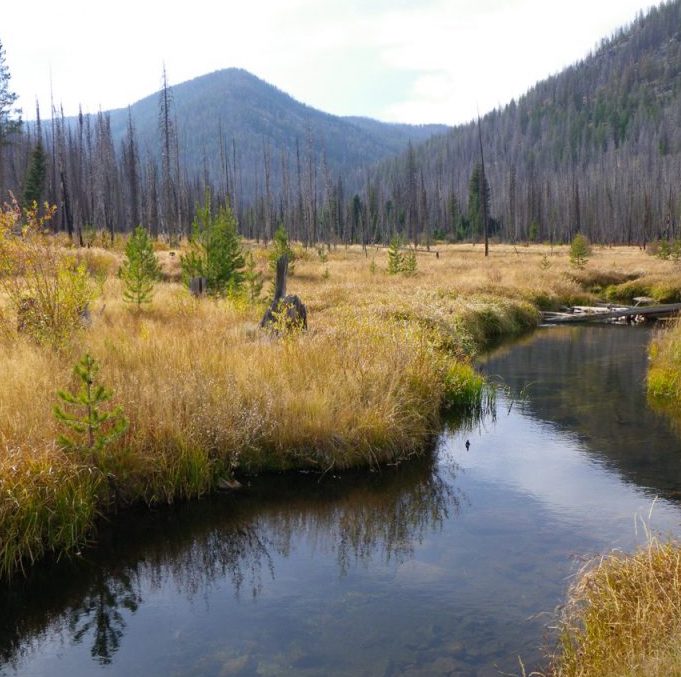Stibnite Gold Project proposed by Perpetua Resources
The South Fork Salmon River is one of Idaho’s most ecologically important watersheds. The river and its tributaries like the East Fork South Fork provide both critical habitat for threatened fish species and world-renowned whitewater recreation opportunities. Think of a younger, scrappier sibling of the Middle Fork Salmon River. Unfortunately, the region also faces challenges. The historic Stibnite mining area in the headwaters of the East Fork South Fork suffers from historic mining pollution, and the river itself currently flows through an abandoned mining pit which forms a fish passage barrier. The river also faces another threat with a new proposed project – the Stibnite Gold Project.
Mining company Perpetua Resources (formerly Midas Gold) is in the advanced stages of permitting a massive open-pit cyanide vat leach mine at the Stibnite site. The Stibnite Gold Project is being presented as a restoration project and Perpetua highlights several notable conservation goals such as restoring fish passage through the historic mine pit and stream habitat improvements, but a closer look at other elements of the plan raises alarm (see list below).
Perpetua also made some modifications to its previous mine plan in response to public concerns and now plans to backfill one of the open pits and place covers on top of tailings and waste rock piles to reduce the amount of pollutants flowing into groundwater. While these are steps in the right direction, they do not go far enough. Over half of the 3,500 acres of disturbance would still be in pristine, undisturbed areas. The new analysis shows that mining activities will still lead to a net loss of habitat for bull trout, among other significant negative impacts.
The Forest Service released a 1,667 page Supplemental Draft Environmental Impact Statement in 2022 that raises additional concerns.

These other impacts include the following:
- Rerouting the East Fork South Fork Salmon River through a mine tunnel and excavating a 400’ deep open pit underneath the former riverbed. This pit will eventually be backfilled with waste rock and the river reconstructed on top.
- Constructing three open pits totaling 510 acres, only two of which would be backfilled.
- Permanent loss of the Meadow Creek bull trout spawning area under 400’ of mine tailings.
- Diverting up to 20% of the flow in a section of the East Fork South Fork to support mining activities.
- Exclusion of bull trout from certain spawning areas for decades due to excessive temperatures following mining activities.
- Fragmenting wildlife habitat by constructing the new 15-mile long Burnt Log mine access road through pristine roadless areas.
- Degradation of the nearby Frank Church-River of No Return Wilderness with noise and light from mining activities and from the construction of a section of the new Burnt Log mine access road along the Wilderness border.

- Increased risk of hazardous materials spills from the transportation of petroleum products, ammonium nitrate, and sodium cyanide. Both proposed access routes have segments exposed to landslide/rockfalls and avalanches, raising the probability of accidents and spills.
- Loss of public access, as public access through the mine site to the Thunder Mountain area will be managed by Perpetua with control measures such as security checkpoints and security surveillance patrols. Recreation opportunities in the 14,221-acre Operations Area Boundary would be closed to unrestricted public access.
- Extensive groundwater pollution within the mine site, requiring a water treatment facility to operate for at least 40 years after closure.
- Elevated levels of arsenic and particulate matter pollution from dust that may pose a public health risk immediately next to the mine site, which led ICL and others to appeal Perpetua’s Air Quality permit in July 2022.
- Creation of the West End pit lake with predicted arsenic and mercury concentrations above Water Quality Standards during and after operations with perpetual impacts to fish.

The Supplemental DEIS was released in October 2022 and the public had until January 10, 2023 to submit comments. Thank you to everyone who spoke up for the South Fork Salmon River and voiced their concerns over the flawed mine plan. We have asked the Forest Service to reject both alternatives or develop new alternatives in a Revised Supplemental DEIS. Any new mine plan they develop must be more protective of public health, clean water and fish and avoid the decades of arsenic pollution the proposed mine would create. To stay updated on this issue, sign up for email alerts.
